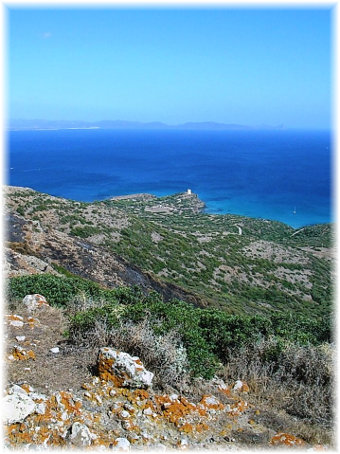





Sant'Antioco is the name of both a municipality and an island, located in the south west corner of Sardinia, in Sulcis zone, one of the least developed locations in the country. It looks out onto the beautiful Golfo di Palmas, with its crystal clear water, and the little, splendid, volcanic islands of Toro, Vacca, Vitello, that lie a little further out to sea, to the south, and onto San Pietro Island, to the north. Sant'Antioco and San Pietro Islands are some of the most magnificent in Sardinia. Sant'Antioco is the fourth largest island in Italy and covers an estimated 109 square kilometers. Santa Caterina links the island to the mainland of Sardinia (there, a beautiful roman bridge to see), so you can get here by car. It is the site of ancient Sulci, probably the second city of Sardinia in antiquity. Today, Sant'Antioco offers a rich archeological heritage. Medieval shrines and a Necropolis (a burial site for stillborn children) can be seen. Interesting the catacombs at the base of the old church at St. Antioco. The museum hosts Roman and Phoenician jewelry, pottery and urns from the nearby Necropolis. From the Castello Sabaudo (su Forte su Pisu - sixteenth century) you can overlook the town of Sant'Antioco. The promenades are shaded by trees, bars, shops and cafes that come to life in the evenings. The port provides boat excursions around the island and to San Pietro (Carloforte). If you want to enjoy a slice of authentic Sardinian life, far from the bustling, tourist crowds of northern Sardinia, come here, and immerse yourself in a really magnificent natural scenery. TripAdvisor gives this description: "Lovely beaches, panoramic views and mouthwatering meals are waiting for you on Sant'Antioco" History: The island of Sant'Antioco was settled at least from the 5th millennium bc. The island houses menhirs, typical tombs (domus de janas and giants' tombs), nuraghes. The city was founded by the phoenicians, with the name of Solki: back to that time we have tophet (a children burial) and necropolis. Later it became a Carthaginian colony, then conquered by the Romans. Its name derives from St. Antiochus, martyred in 126 a.d. After the decline of the Roman Empire, Byzantines and Saracens, under whose attack inhabitants fled to more protected inner areas. Around the end of the first millennium, a new settlement was established by the Judge of Cagliari, and again abandoned after the end of the Giudicato. Kingdom of Sardinia, created in XIV century, reigned on the island, more later acquired by archbishop of Cagliari. Spain, Aragon and Pisa also played a role in island history. In XVIII century Sant'Antioco was occupied by French troops: in this period it also suffered attacks by North African pirates. A complicated and rich history: many ancient peoples have left traces of their passage. To see in Sant'Antioco: The palaeo-christian Basilica of Sant'Antioco, restored in XI century, and catacombs dating as far back as the 6th century BC. Phoenician and Punic necropolises Ancient Acropolis Ferruccio Barreca Archaelogical Museum The ethnographical Museum Roman bridge Su Forte su Pisu Menhir Su Para and Sa Mongia Domus de Janas Giants' Tomb Su Semafuru Grutt'Acqua Torre Canai Tower Chiara Vigo Byssus Museum To see in Calasetta: A picturesque seaside town with a beautiful turist port, a number of excellent restaurants Calasetta Tower Beaches, coves and rocky inlets: Far away from the throngs of tourists and sun worshippers that clutter the upper Sardinia, Sant'Antioco offers a natural heaven of peace: Maladroxia Beach (perfect for families, long sandy shoreline for kids; plenty of cafes, restaurants) Cala Sapone (a small beach but great for swimming and snorkelling, kayak trips, great view, and the best sunset) Coaquaddus (a unique location, great views, easy for families, well equipped beach) Le Saline (shallow waters, safe for children) Spiaggia Grande (the longest beach of the island) Sottotorre (close to Calasetta town, nice place in off season, crowded in summer) Cala Lunga (a hidden, secret cove, relatively quiet, with clear, still water) Cala della Signora, o Cala Tuffi (between Cala Sapone and CalaLunga, rocky, small and cozy, a nice one...) Capo Sperone (the southernmost point in the island: in front of you... the African coastline) Peonia Rosa (pebble beach, in front of you Vacca Island, behind you a pine forest) Is Pruinis (dog beach) Spiaggia delle vasche (not for kids, it is difficult to reach, but it worths...) Is Praneddas (a stunning natural stone arch, sculpted by the waves, absolutely to see, but difficult to find...) Turri (pebble beach, caribbean colours and gorgeous view) Portixeddu (crystal clear water, which shines in every shade of blue) Porto Sciusciau (a wild one, awkward to reach by foot ... better by boat...) Cala Grotta (snorkelling and jumping off the rocks) Mangiabarche and Nido dei Passeri (a cliff over the sea, a lighthouse, San Pietro Island down there. Wonderful sunset) |

